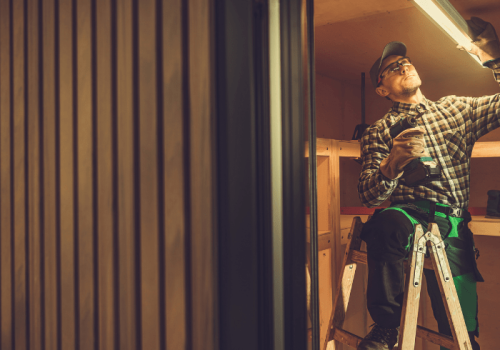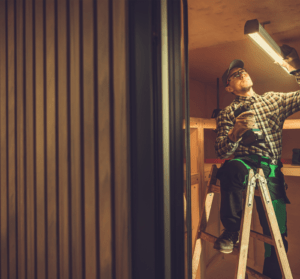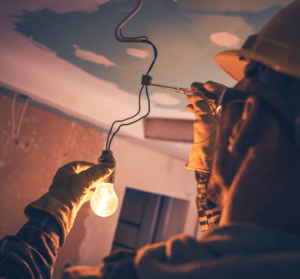Troubleshooting and Repairing Common Light Fixture Issues
Light fixtures are important for safety, creating a nice atmosphere, and being efficient. They light up our homes and workplaces, helping us do everyday tasks easily. But when these lights stop working, it can mess up our routines and even be dangerous.
Broken light fixtures can make it hard to do your daily activities and make your home or workplace less safe and comfortable. In this guide, we will show you how to find and fix common problems with light fixtures. By following our easy steps, you can make sure your lights are working well again, which will help keep your environment safe and productive.

Common Light Fixture Issues
Light fixtures, like all electrical components, are susceptible to a variety of issues. From flickering and dimming to buzzing noises and overheating, understanding and addressing these problems can extend the life of your fixtures and maintain the integrity of your electrical system.
Flickering Lights
Flickering lights are not only annoying but can also be indicative of underlying electrical problems. Common causes include loose bulbs, faulty switches, voltage fluctuations, or issues with the electrical panel. In some cases, flickering can result from incompatibility between dimmer switches and LED bulbs.
Steps to Diagnose Flickering Issues
To diagnose flickering issues, start by tightening the light bulb. If the flickering persists, check the switch for any signs of wear or damage. Testing the fixture with a different bulb can help rule out bulb-specific problems. If these steps don’t resolve the issue, it may be necessary to consult a professional electrician to examine the wiring and voltage levels.
Dead Light Bulbs
Frequent bulb burnouts can be frustrating and costly. Common reasons include using bulbs with incorrect wattage, poor electrical connections, or excessive vibrations in ceiling fixtures. Overheating due to insufficient ventilation can also cause bulbs to burn out prematurely.
How to Properly Replace Light Bulbs
To replace a light bulb, ensure the fixture is turned off and cool to the touch. Remove the old bulb by unscrewing it counterclockwise. Insert the new bulb by screwing it in clockwise until snug. Ensure you use the correct wattage and type of bulb for the fixture to avoid further issues.
4. Dimming Lights
Dimming lights can occur due to several reasons, such as overloaded circuits, incompatible dimmer switches, or failing light bulbs. Additionally, voltage drops caused by high-demand appliances can lead to temporary dimming.
Troubleshooting Dimmer Switches
Begin troubleshooting by checking the compatibility of your dimmer switch with the type of bulb used. Ensure the dimmer is not overloaded with too many fixtures. If the problem persists, inspect the wiring connections and consider replacing the dimmer switch with a newer model designed for modern bulbs.
5. Buzzing or Humming Noises
Buzzing or humming noises from light fixtures can be unsettling. These sounds often stem from issues such as loose components, electrical arcing, or incompatible dimmer switches. Fluorescent lights are particularly prone to making such noises when the ballast starts to fail.
Solutions to Eliminate Buzzing
To eliminate buzzing, start by tightening any loose parts within the fixture. If the noise continues, replace the bulb with a higher-quality one designed to operate silently. For fixtures with dimmer switches, ensure the switch is compatible with the bulbs. If buzzing persists, it may be necessary to replace the ballast or consult an electrician.
6. Overheating Fixtures
Overheating fixtures are a serious concern as they can lead to fire hazards. Common causes include using bulbs with wattage higher than recommended, poor ventilation, and faulty wiring. Overheating can also result from fixtures being installed too close to insulating materials.
Preventative Measures
To prevent overheating, always use bulbs that match the fixture’s wattage rating. Ensure fixtures are well-ventilated and not covered by insulation. Regularly inspect the wiring for any sign of damage or wear. Consider installing thermal protectors in recessed lighting to automatically shut off if overheating occurs.
7. Faulty Wiring
Faulty wiring can present as flickering lights, frequent bulb burnouts, or tripped circuit breakers. Other signs include discolored outlets or switches, a burning smell, or slight electric shocks when touching fixtures. Such symptoms should not be ignored as they pose serious safety risks.
Safe Practices for Repairing Wiring
When addressing wiring issues, always turn off the power at the circuit breaker before beginning any repairs. Use insulated tools and wear protective gear. If unsure, consult a licensed electrician. Never attempt to repair live wires, and ensure all connections are secure and properly insulated.
8. Malfunctioning Light Switches
Malfunctioning light switches can result in lights that don’t turn on or off properly. Common issues include worn-out internal mechanisms, loose wiring, or outdated switch designs. Testing the switch with a multimeter can help determine if it’s the source of the problem.
Steps for Repair or Replacement
To repair or replace a light switch, first turn off the power at the circuit breaker. Take off the switch cover and detach the switch from the wall. Inspect the wiring for any indications of wear or damage. Replace the switch if necessary, ensuring all connections are tight and secure before restoring power.
When to Call A Professional Electrician
While many light fixture issues can be addressed by homeowners, there are times when calling a professional electrician is essential. Complex wiring problems, persistent electrical failures, and safety concerns are beyond the scope of DIY repairs. If you encounter frequent circuit breaker trips, burning smells, or any signs of electrical arcing, it is imperative to seek professional assistance. Licensed electricians have the expertise to diagnose and rectify electrical issues safely, ensuring the longevity and safety of your home’s electrical system.





